The Impending Reality of Destructive Technology and Weaponry in “A Dream of Armageddon” and La Guerre des Mondes by Caroline Petrow-Cohen

H.G. Wells’ iconic and prototypical science fiction novel The War of the Worlds was published in 1898, just three years prior to the publication of Wells’ short story, “A Dream of Armageddon.” Both works deal with themes of war, technology, and destruction, and because of these commonalities, the illustrations in La Guerre des Mondes (A 1906 French translation of The War of the Worlds) closely reflect the imagery in “A Dream of Armageddon.” In both stories, the mechanization of war causes vast and virtually inescapable devastation to the landscape and its inhabitants. When La Guerre des Mondes’ illustrations are analyzed in comparison to Well’s descriptive language in “A Dream of Armageddon,” the parallels between the types of warfare found in each story become clear. But the most compelling implication of these parallels comes not from how each story is similar, but from one key way in which they differ.
In La Guerre des Mondes, Martians invade Earth with giant and powerful tools of war, which utilize technology far more advanced than anything conceivable in late 19th century Europe. In “A Dream of Armageddon,” worldwide war is waged with similar high-tech weaponry, but in this story, the weapons come not from an alien species but from regular people. The war in “A Dream of Armageddon” is set in the future, possibly around the year 3,000, as the narrator suggests. This war is still not rooted in reality, as it unfolds in a dream. But the progression from Well’s 1898 novel to his 1901 short story — the progression from associating destructive, technologically advanced weapons with an alien planet, to associating these weapons with a future version of Earth — suggests the impending existence of such weapons.
Eerily, Wells’ prediction was relatively accurate. While La Guerre des Mondes was published eight years after the original English novel, its illustrations still predate World War I by nearly 10 years. During the pre-war years, human society inched closer and closer to creating weapons of mass destruction and inventing a new kind of mechanized warfare. The Wright brothers launched the first successful airplane in 1903, and six years later, in 1909, the brothers built the first military airplane. Just five years after that marked the beginning of World War I, the first war in which aircraft were widely used for combat. It seems to me as if Wells’ was issuing a warning with these two works: high-tech weapons are not just an imaginary concept from Mars, as La Guerre des Mondes depicts, but instead they are an imminent reality, waiting for us some time in the future.
“A Dream of Armageddon” tells the story of a man’s hyperrealistic recurring dream. The man is actually a solicitor named Cooper, but in the dream, he is an important political figure named Hedon. Hedon flees his responsibilities and abandons his followers in order to live a simple, peaceful life with the woman he loves. When Hedon learns that a war is brewing in the North and only he can prevent it, he chooses to ignore his duty and stay with his lover, who is not named. The pair attempt to reach safety amidst the growing war, but the woman is ultimately killed by stray gunfire. There were many images in La Guerre des Mondes that vividly reminded me of the language in “A Dream of Armageddon,” and I will outline a few illustrations that I thought had the strongest connections to Well’s short story:
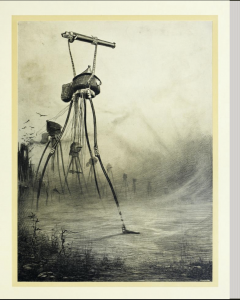
As Hedon and his unnamed Lady attempt to flee the war, they see “a squadron of aeroplanes flying across the southern sky… a line of dots … and then more, dotting the south-eastern horizon, and then still more, until all that quarter of the sky was stippled with blue specks.” The illustration below depicts a similar scene, with the war machines lined up in a seemingly infinite formation, spreading across the entire area. The descriptions of a “line of dots” and a sky stippled with machinery almost perfectly match this illustration.
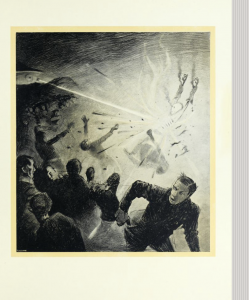 In the attack where his lady is killed, Hedon describes the bullets that rained down on them from a plane: “Overhead in the sky flashed something and burst, and all about us I heard the bullets making a noise like a handful of peas suddenly thrown. They chipped the stones… and whirled fragments from the bricks.” In the image below, there is a “flash” and “burst” overhead, and people try to take cover. I imagine there would be similar sounds in the scene in the image, like hard peas hitting the ground, as shrapnel flies. The image shows a person being zapped by something, and the body explodes outwards. This is, of course, not literally the same as the situation that Hedon was in, but the imagery is closely related in both scenes.
In the attack where his lady is killed, Hedon describes the bullets that rained down on them from a plane: “Overhead in the sky flashed something and burst, and all about us I heard the bullets making a noise like a handful of peas suddenly thrown. They chipped the stones… and whirled fragments from the bricks.” In the image below, there is a “flash” and “burst” overhead, and people try to take cover. I imagine there would be similar sounds in the scene in the image, like hard peas hitting the ground, as shrapnel flies. The image shows a person being zapped by something, and the body explodes outwards. This is, of course, not literally the same as the situation that Hedon was in, but the imagery is closely related in both scenes. 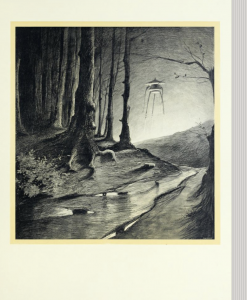
In this illustration, the machine of war in the distance is in contrast with the nature around it. The machine is threatening and out of place, and it’s reasonable to think that one might be able to hide or find shelter in the trees. Hedon describes how he and his lady took refuge from the warplanes by hiding in nature: “Several times we had hidden in woods from hovering aeroplanes.”
It was startling to me how the imagery in “A Dream of Armageddon,” often perfectly fit the visuals in La Guerre des Mondes. And, as some of my peers point out, these visuals closely reflect modern day weapons. Warplanes that can fire off bullets and explosives are commonplace in today’s wars, and my classmate noted that one of the images looks like a drone strike. A drone strike is an even more technologically advanced type of combat, as it involves unmanned, autonomous aircraft. Autonomous weaponry and self-improving AI have the potential to bring about a new generation of wildly destructive technology. With machine learning, AI is capable of outpacing human intelligence. This poses a threat so extreme that it’s easier to write it off as unrealistic, but to do so would be to ignore Wells’ words of warning. The way that written descriptions of human weapons can be applied to visual illustrations of alien weapons is at the crux of the meaning I find in my comparison of La Guerre des Mondes and “A Dream of Armageddon.” The most frightening and most outlandish scenes of violence and destruction that we can imagine may not really be as unrealistic as we think.
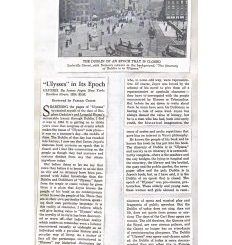

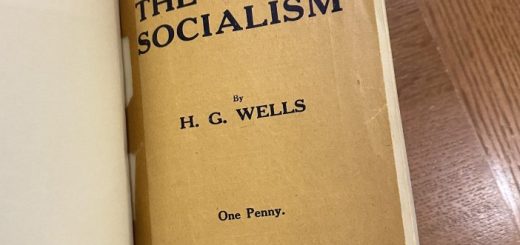







Recent Comments